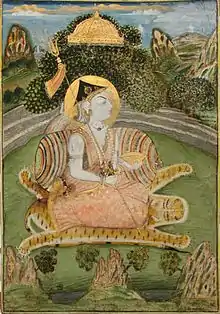Navnath
The Navanath (Sanskrit: नवनाथ), also spelt as Navnatha and Nao Nath in vernacular languages, are the nine saints, Masters or Naths on whom the Navnath Sampradaya, the lineage of the nine gurus is based.[1] They are worshipped collectively as well as individually.[2]
| Part of a series on |
| Shaivism |
|---|
 |

Nine gurus

Some members of the Nath Sampraday believe Rishi Dattatreya, an incarnation of the Hindu trinity Brahma, Vishnu and Shiva was its first teacher.[1][3][4] Other traditions hold that Matsyendranath received initiation directly from Shiva, also known as Adi Nath. In many modern Nath groups, worship of Gorakshanath and Shiva is primary. The nine teachers, collectively known as Navnaths, are considered representative of great teachers in this tradition or parampara.[4]
Several lists are known:
Frydman
According to Maurice Frydman, the editor of Sri Nisargadatta Maharaj's I Am That, "the most widely accepted list"[5] is as follows:
- Machindranath or Matsyendranath
- Gorakshanath or Gorakhnath
- Jalandharnath or Jalandernath also known as Jan Peer
- Kanifnath or Kanhoba
- Gahininath also known as Gaibi Peer
- Bhartrinath or Bhartarinath or Raja Bhartari or Bhartṛhari
- Revananath or Revan Siddh or Kada Siddha or Ravalanath
- Charpatinath
- Naganath or Nageshnath
Mullarpattan
Suamitra Mullarpattan, translator of Nisargadatta Maharaj, gives the following list:[4]
- Matchindra-Nath (9th Century), "who was said to be, initiated by one of the three primary Hindu gods (Vishnu, Shiva, Brahma), namely by Shiva, in the science and teaching of Yoga."[4]
- Goraksha-Natha
- Jalandhar-Nath
- Kanifanath
- Charapati-Nath
- Naganath
- Bhartari-Nath
- Revan-Nath
- Gahininath
List 3
Matsyendranath (the chief natha), Gorakshanatha, Charpatinatha, Mangalnatha, Ghugonatha, Gopinatha, Prannatha, Suratnatha and Cambanatha. They are not related to the divisions of the orders.[6]
List 4
In another list each Natha is identified with a Hindu god:1. Aumkar Adinatha (Lord of Lords), Siva; 2. Shelnatha (Lord of the Arrow Shaft), Krisna or Rama Chandra; 3. Santoknatha (Lord of Gratification) 4. Acalacambhunatha (Lord of Wondrous Immortality), Hanuman or Laksman; 5. Gajbali Gajkanthnatha (Lord of the Elephant's Strength and Neck)) Ganesa Gajikarna (Elephant-Eared); 6. Prajnatha, or Udaynatha (Lord of the People), Parvati; 7. Mayarupi Macchendranatha (The Wondrous Form), Guru of Gorakhnatha; S. Gathepinde Ricayakari, or Naranthar, Sambhujaiti Guru Gorakhnatha; 9. Gyansarupe, or Purakh Siddh Cauranjwenatha, or Puran Bhagat.[6]
List 5
Orhkarinath, Visnu; Samtokanath, Visnu; Gajboli, Gajana, Hanuman; Acalesvar, Ganpati; Udayanatha, Surya; Parvati Prem, Mahadeo; Santhanatha, Brahma; Gyaniji Siddhacewarafigi, Jaggannath; Mayarupi, Matsya. The Nathas are also the guardian spirits of the Himalayan peaks.[6]
List 6
1.Adinath 2. Udaynath Parvati 3.Satyanath Brahamaji 4.Santoshnath Vishnuji 5.Achabhenath Shesh 6.Kanthadnath Ganeshji 7.Chaurangi Chandrma 8.Matsyendranath 9.Gorakhnathh.[6]
List 7
Omkarnath, Udaynath, Santoshnath, Achalnath, Gajbalinath, Gyannath, Chauranginath, Matsyendranath, Gorakhnath.[6]
List 8
Macchendranatha, Gorakhnath, Jalandhernath, Kanifnath, Charpatinath, Naagnath, Bhartrharinath, Gahininath, Ravennath.[6]
List 9
Shri Gorakhnath, Javaalendranath, Kaarinanath, Gahini nath, Charpath nath, Revan nath, Naag nath, Bharthari Nath, Gopichand Nath.[6]
The nine Naths are the incarnations of Nine Narayanas who help Lord Narayan in taking care of the worldly activities. Lord Krishna had summoned the nine Narayans to his court for deciding the establishment of Nath Sampraday.
Narratives
Navnath pothi / Navnath Bhaktisar
The "Navnath Bhaktisar" also known as the"Navnath pothi" narrates the Navnaths' births, their lives and deeds. As the Navnath are strongly worshiped in Maharashtra, the book is written in Marathi. It is written by Malu Narhari. In this text, the author mentions at the end of each chapter that this text is a taken from original text which is also in Marathi 'Kimayagaar' by Gorakhnath, one of the Navnath.
Mahabharata
The coming of the Navnath - or nine prophets - is mentioned in the Mahabharata. Krishna called a meeting of all demi-gods, angels and saints to give his message of how he would continue his message of spreading good after his mission is over on earth. Krishna said he would send his own light in the form of nine saints or prophets, who will go to different parts of earth and throughout the universe where life exists. Lord Krishna also mentions that these prophets or saints will spread the message of Love, overcoming obstacles in order to unite with Mahavishnu or Shiva or Shakti. Krishna said that they would help only those who have good souls and believers.
Navnath Sampradaya
The Navnath Sampradaya or 'Navnath Parampara', is a Hindu sampradaya or parampara based upon the lineage of the Navnaths.[4]
The Navnath sampradaya spreads the message of Krishna that God exists everywhere and not just in a particular form or lack thereof. The Avatar of Dattatreya (Unified form of the trinity) came on the mission on earth to dispel confusion of earthlings who thought the three are different.
The teachings of the Nath Sampradaya have, over the centuries, become labyrinthine in complexity and have assumed different forms in different parts of India. Its teaching emphasises that the Supreme Reality can be realised only within the heart.In the day-to-day instructions to their devotees the Nath Gurus seldom refer to the metaphysics discovered by the scholars in their teachings. Chanting of sacred hymns and devotional songs as well as the worship of the idols is a traditional feature of the sect. There is an ancient temple of navnath in pulgaon on the bank of wardha river .
Further reading
References
- nisargadatta.org, Navnath Sampradaya Archived 2015-02-23 at the Wayback Machine
- Berntsen 1988.
- I Am That, by Nisargadatta Maharaj, chapter 97, Part II, Page 271
- Boucher & year unknown.
- Frydman 187.
- "Shri Gorakhanath". gorakhnath.org. Retrieved 2020-07-04.
Sources
- Berntsen, Maxine; Zelliot, Eleanor (1988). The Experience of Hinduism: Essays on Religion in Maharashtra. Albany, N.Y: State University of New York Press. pp. 338. ISBN 0-88706-662-3.
- Boucher, Cathy (n.d.), The Lineage of Nine Gurus. The Navnath Sampradaya and Sri Nisargadatta Maharaj
- Frydman, Maurice (1987), Navanath Sampradaya. In: I Am That. Sri Nisargadatta Maharaj, Bombay: Chetana
